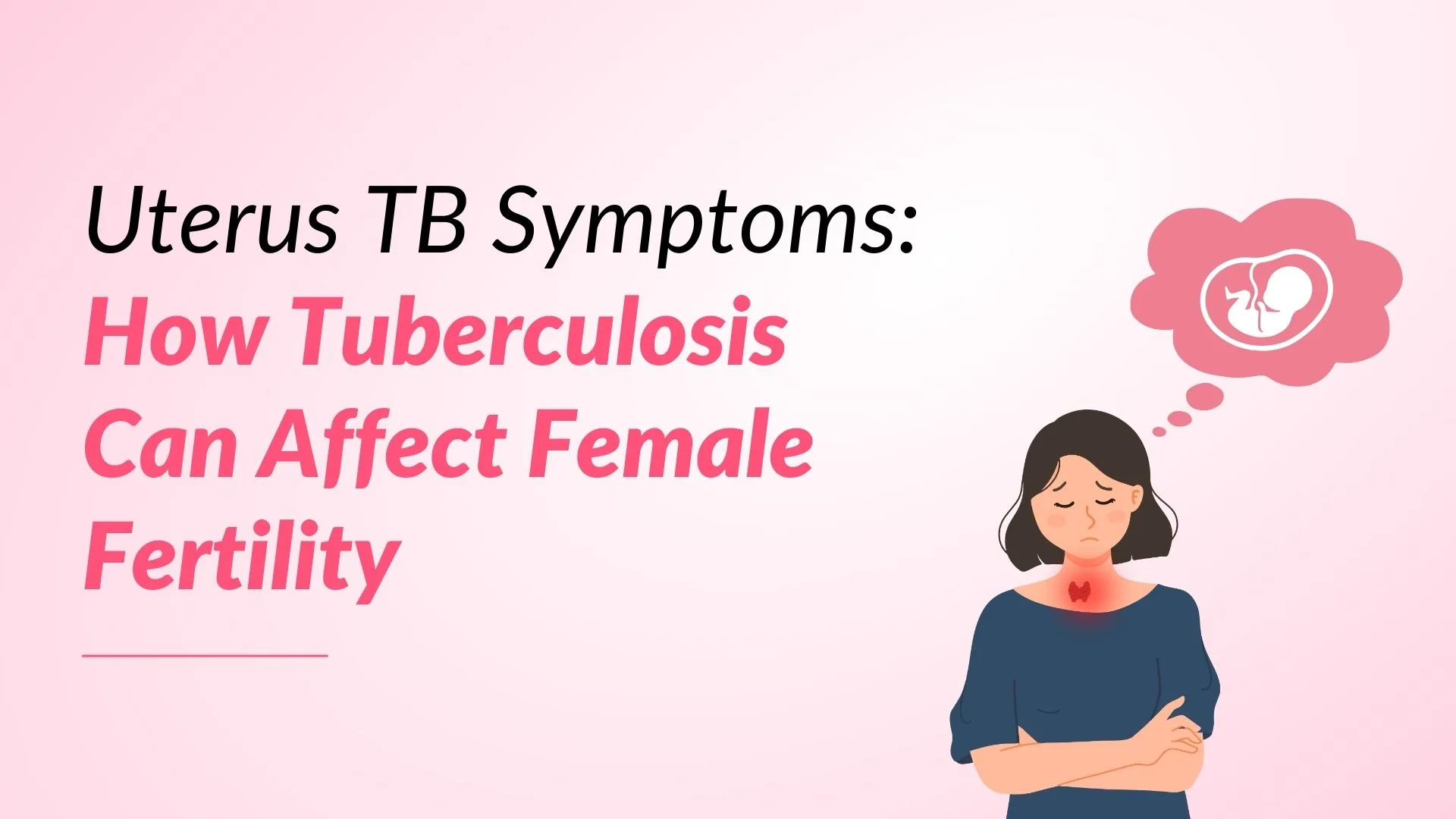When we think about tuberculosis, we frequently picture a lung condition that causes coughing and breathing problems. In fact, the most prevalent manifestation is this initial type, also referred to as pulmonary tuberculosis. Many people are unaware that tuberculosis is dormant, which means that the bacteria that cause the disease may survive in the body and be inactive for decades. These bacteria can grow active and begin to cause issues, especially when the immune system is weakened. These tiny bacteria enter the circulation and spread to the reproductive organs, resulting in genital tuberculosis (TB in the uterus). Tuberculosis infects the male reproductive organs, such as the testis, prostate, or epididymis, and in females, it affects the fallopian tubes, uterus and ovaries. They have a significant impact on male and female fertility.
Also read: Symptoms of Blocked Fallopian Tubes
What is Uterine TB (Genital Tuberculosis)?
Genitourinary TB is a frequent form of extrapulmonary tuberculosis (EPTB) globally (27%), with genital TB accounting for 9% of all EPTB cases. Female genital tuberculosis is a chronic diseasecharacterized by mild symptoms. Almost all cases of genital tuberculosis impact the fallopian tubes, and this, along with uterine involvement, produces infertility. Once bacteria have colonized the reproductive organs, they can create problems in a number of ways. This condition is known as Uterine TB (Genital Tuberculosis). Many women present with unusual symptoms that resemble other gynaecological conditions. A combination of tests is required to establish the diagnosis of female genital tuberculosis (FGTB).
Also Read: How Does the Uterine Environment Affect Embryo Health?
How Tuberculosis Spreads to the Reproductive System?
Tuberculosis (TB) is a contagious bacterial infection that mostly affects the lungs. However, this condition can extend to other parts of the body, resulting in a variety of consequences. Female genital tuberculosis (FGTB) is caused by Mycobacterium tuberculosis (occasionally Mycobacterium bovis and/or atypical mycobacteria) and is typically subsequent to TB of the lungs or other organs, with the infection spreading through the bloodstream, lymphatic system (lymph nodes), or direct route from abdominal TB. Genitourinary tuberculosis infects the male reproductive organs (such as the testicles, prostate, or epididymis). Symptoms of TB in males may include scrotal swelling, testicular pain, epididymal mass, discharge from the penis, increased frequency of urination, burning or pain during urination (dysuria), and blood in the urine. Reduced sperm transport due to scarring or obstruction of the reproductive ducts might result in infertility in males.
Common Symptoms of Uterine TB
Uterine tuberculosis (TB) is a type of tuberculosis that affects the inner lining( Endometrium) of the uterus and can cause infertility and menstrual abnormalities. The signs of uterine tuberculosis are not usually clear, and the common symptoms of uterine TB in females include irregular menstrual periods,scanty flow, pelvic pain, and infertility.
Irregular Menstrual Cycles
TB’s influence on the endometrium can alter the menstrual cycle, making it more difficult for women to conceive. TB can cause irregular periods, such as amenorrhea (no periods), oligomenorrhea (infrequent periods), or menorrhagia (heavy periods).
Pelvic Pain or Discomfort
Pelvic pain or discomfort is a common symptom of uterine tuberculosis (TB). It can vary in intensity, from mild to severe, and may be chronic or intermittent. The pain is often felt in the lower abdomen or pelvis and may worsen during menstruation or sexual intercourse. This pain results from the infection-induced inflammation and scarring of the uterine tissues.
Abnormal Vaginal Discharge
Although it is less frequently discussed, abnormal vaginal discharge is another potential symptom of uterine tuberculosis (TB) in females. This symptom occurs due to inflammation and infection in the lining of the uterus. Particularly during or after menstruation, the discharge may be thicker than normal, foul-smelling, and frequently yellowish or greenish due to infection.
Also Read: Essential Tips for Maintaining Optimal Vaginal Hygiene
Difficulty in Conceiving
Infertility, or difficulty conceiving, is a serious and prevalent problem linked to uterine tuberculosis (TB) . A woman’s ability to conceive may be hampered by the infection’s potential to damage and scar the fallopian tubes, pelvic cavity, and uterine lining.
Unexplained Weight Loss and Fatigue
Although they are more frequently linked to active TB in other areas of the body, like the lungs, unexplained weight loss and fatigue are possible symptoms of uterine TB. These symptoms may arise from the overall effects of uterine tuberculosis on the body.
How Uterine TB Impacts Female Fertility?
Female fertility can be greatly impacted by uterine tuberculosis (TB) , which frequently results in infertility. Inflammation, scarring, and damage to the uterus, fallopian tubes, and surrounding structures are the main effects of the infection on the reproductive organs. In order to maintain fertility and increase the likelihood of pregnancy, early diagnosis, and appropriate treatment are essential.
Damage to the Endometrial Lining
An endometrial infection from tuberculosis might result in irregular bleeding. On the other hand, you may have heavy bleeding or infrequent periods. It may also cause thinning of the endometrial lining, which decreases chances of implantation of embryos and might result in infertility and difficulties throughout pregnancy like miscarriage. It can also damage endometrium and cause adhesions inside the uterus obstructing the cavity of the uterus making pregnancy impossible without surgical correction.
Tubal Blockages and Adhesions
Fallopian tubes transport egg and sperm and provide ideal conditions for fertilization which makes them crucial for fertility. But fallopian tube tuberculosis may damage and affect these tubes, which can result in tubal block or hydrosalphinx. In addition to delaying the egg’s journey, this raises the possibility of ectopic pregnancies, in which the embryo implants outside the uterus due to TB in the fallopian tube.
Also Read: Symptoms of Blocked Fallopian Tubes
Increased Risk of Miscarriage
By compromising the endometrium’s health, thickness and integrity, tuberculosis makes it difficult for an embryo to implant and thrive. Miscarriage risk rises in those circumstances.
Also Read: Six Steps to Prepare for Pregnancy Following a Miscarriage
Diagnosing Uterine TB: Tests and Procedures
It is difficult to detect genital or uterine TB because it doesn’t manifest until you try to conceive or experience problems having sex or becoming pregnant. Genital TB can also occasionally be mistaken for endometriosis or other diseases of the reproductive system. In order to determine the underlying cause and create a personalized treatment, your fertility specialist will do a comprehensive physical examination and collect your medical history, including any exposure to HIV or TB. Other tests to diagnose genital tuberculosis include:
- Imaging Testing- HSG, Pelvic Ultrasound
- Laparoscopy
- Endometrial Biopsy and
- Bacterial cultures
These diagnostic resources offer a thorough method for identifying genital TB, evaluating its effect on fertility, and directing the development of effective treatment plans.
Treatment Options for Uterine TB
Your fertility specialist will determine the root causes and recommend the best fertility and uterine TB treatments . Among the treatments available to enhance reproductive health are:
Antibiotic Therapy
Similar to the method used for pulmonary tuberculosis, anti-tuberculosis therapy (antibiotic therapy) is the mainstay of treatment for female genital tuberculosis. A prescribed medication regimen is part of antibiotic therapy, and the duration and combination of these medications is determined by the extent and severity of the condition.
Surgical Interventions for Severe Cases
In certain instances, surgical procedures are employed when the primary cause of female infertility is extensive scar tissue. Depending on the extent of the damage, this could include guided laparoscopic and hysteroscopic treatments to remove damaged and scarred tissue or separate adhesions. The goal is to repair and restore function.
Can Fertility Be Restored After Uterine TB?
Fertility can be restored following uterine tuberculosis (TB), but the success rate is primarily determined by the extent of the infection’s damage and how quickly it is diagnosed and treated. While uterine tuberculosis can cause substantial reproductive problems, many women who receive timely and proper treatment can conceive successfully. Women experiencing infertility with a history of uterine TB should meet with a fertility specialist to discuss the appropriate treatment options. Some factors that influence the restoration of fertility are;
- Early diagnosis
- Extent of damage
- Surgical intervention
- Prompt treatment plans
- Assisted reproductive technologies-IUI/IVF
Preventing Genital Tuberculosis
The severity of tuberculosis’ impact on fertility varies based on factors such as the infection’s degree, duration, and the body’s response to treatment. It is important to highlight that TB-related infertility can frequently be reversed with proper medical treatment and care. It is always better to prevent than to cure.
- In our country, all newborns receive the BCG vaccine for this disease as part of the National Immunization Program
- The most crucial step in preventing genital TB is the early identification and proper treatment of active tuberculosis
- Avoiding prolonged contact with people who have active tuberculosis, particularly those with untreated pulmonary TB, can help avoid transmission
- Maintaining proper hygiene, such as frequent handwashing and wearing face masks in busy or high-risk places, can help minimize the spread of tuberculosis bacteria
- Women who are at higher risk of TB, such as those with a history of untreated or inadequately treated pulmonary tuberculosis or who are immunocompromised, should undergo regular gynecological check-ups
- A healthy lifestyle, which includes good nutrition, exercise, and stress management, can boost the immune system and lower the risk of acquiring tuberculosis
Conclusion
Female genital tuberculosis is a silent but serious health risk. Its impact on fertility, as well as the challenges of detecting and treating it, make it an important concern for women’s health. Awareness, early detection, and appropriate tuberculosis treatment are critical for controlling FGTB and limiting its impact on women’s reproductive health. In order to maintain fertility and increase the likelihood of pregnancy, early diagnosis, emotional support, and suitable treatment are essential to prevent serious consequences.





























